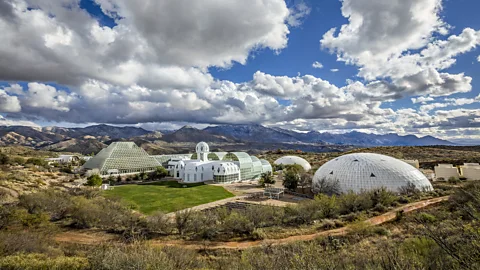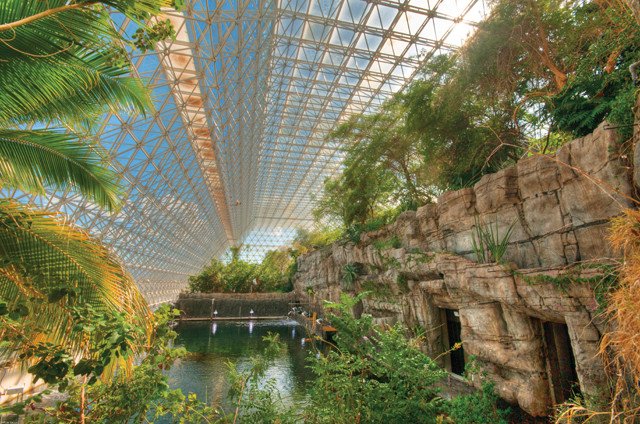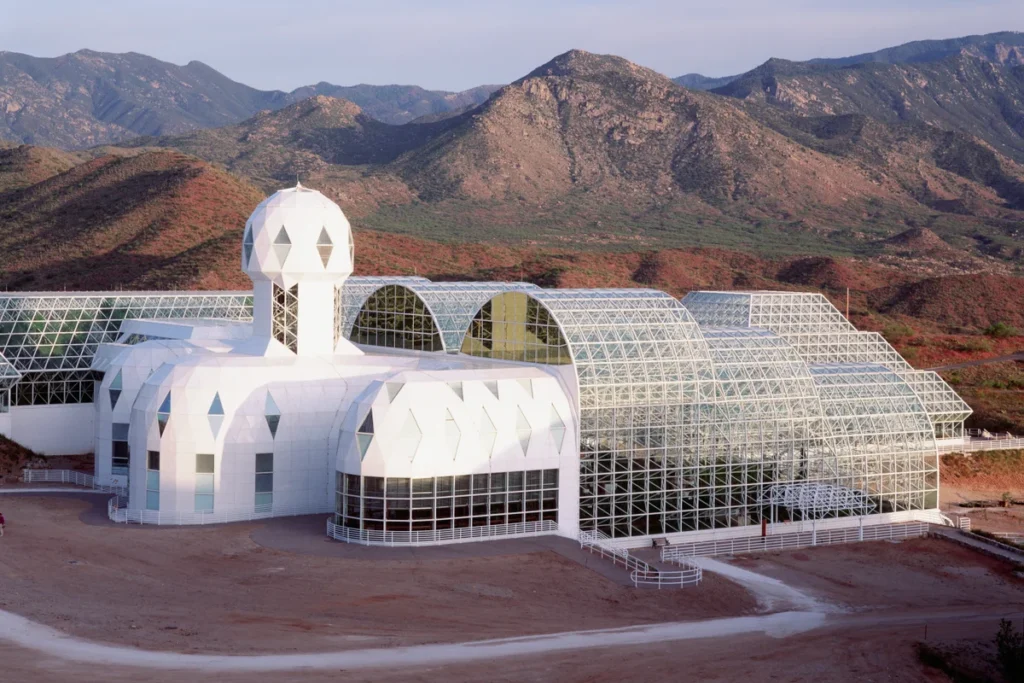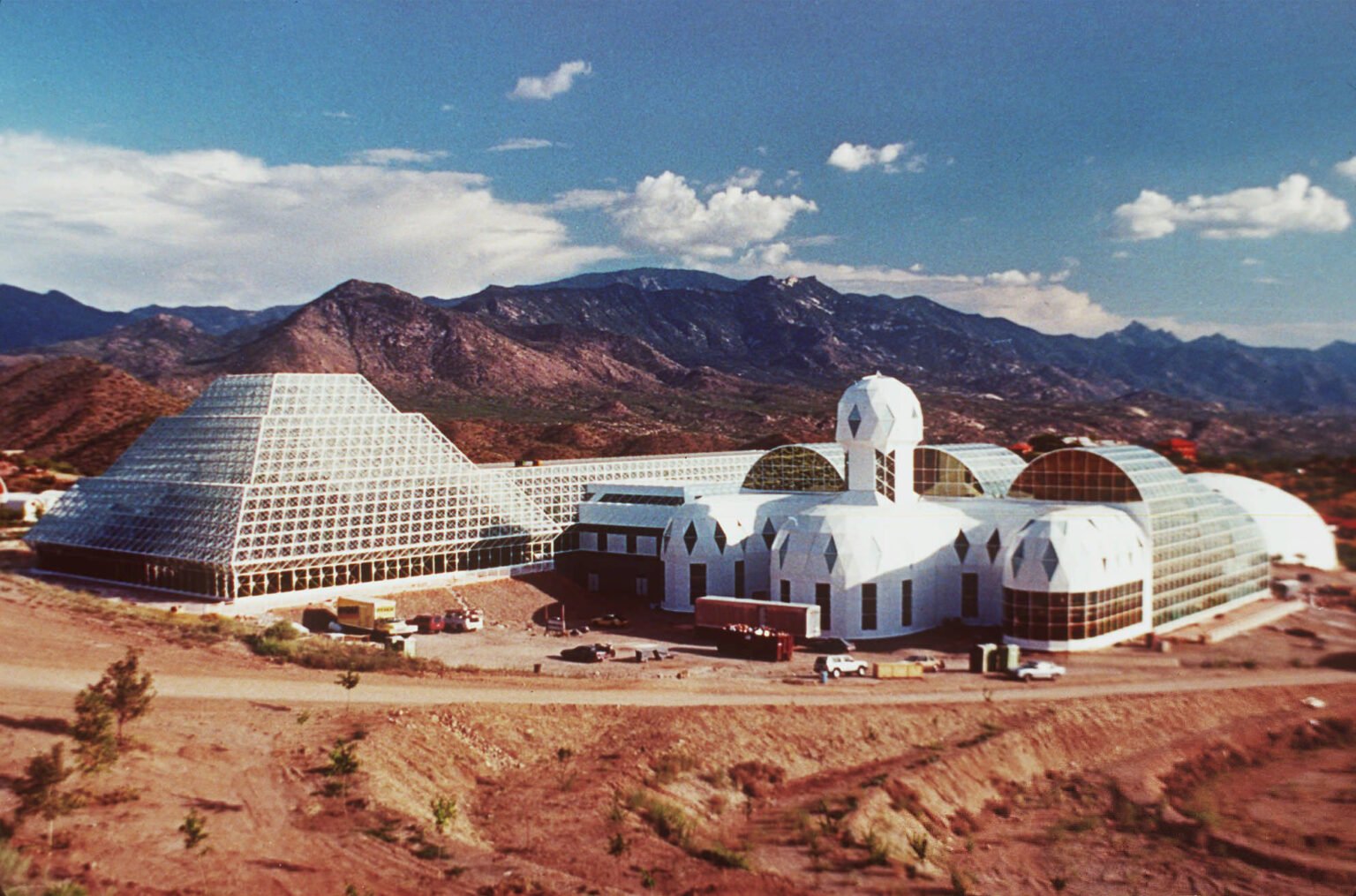Biosphere 2: The Sealed Experiment That Redefined Earth Science
The Biosphere 2 experiment was one of the most ambitious ecological projects ever attempted. Hidden in the arid landscapes of Arizona, this three-acre glass complex contains a rainforest, a desert, an ocean with a coral reef, and other ecosystems — all sealed under shimmering domes. Envisioned as a miniature Earth, Biosphere 2 aimed to test whether humans could live in a closed-loop system, offering critical insights into sustainability, climate science, and life beyond our planet.

In 1991, eight individuals embarked on a daring scientific mission: to live sealed inside Biosphere 2 for two years. They cultivated food, recycled their own water and air, and attempted to survive within this closed ecosystem. Although the mission faced significant challenges, including dangerously low oxygen levels and loss of biodiversity, it left behind invaluable lessons that still shape environmental science today.
The Vision Behind Biosphere 2
The Biosphere 2 experiment was the brainchild of a group of ecologists and visionaries, led by systems ecologist John Allen and financially backed by billionaire Ed Bass, who invested nearly $150 million into the project. Far from being just a rehearsal for life on Mars or the Moon, the Biosphere 2 experiment aimed to deepen our understanding of how Earth’s biosphere functions as a closed, interconnected system.
Under Allen’s leadership, Biosphere 2 was constructed with the most advanced technologies of its time. Inside, it hosted miniature versions of Earth’s biomes: a tropical rainforest, mangrove wetlands, savannah, desert, and a marine system. It even included an agricultural area for growing food and an energy center to support the internal systems.
Life Inside a Closed System
In September 1991, the eight “biospherians” entered the sealed facility. Their mission was to prove that humans could survive in a completely closed ecological system. Initially, the experiment inspired awe and optimism, but soon, the cracks began to show.
The air quality began to deteriorate as oxygen levels fell from 21% to 14%, equivalent to the oxygen levels at high altitudes. This led to fatigue, altitude sickness, and difficulty maintaining daily tasks. Scientists later discovered that oxygen was being consumed by soil microbes and was also being absorbed by the concrete walls, which had not fully cured.

Meanwhile, carbon dioxide levels fluctuated wildly, and pollinating insects began to vanish, threatening crop sustainability. Crazy ants overran the system, preying on essential species. While the biospherians managed to grow food, they lost significant body weight, becoming subjects for calorie restriction research.
Despite these obstacles, they persevered. They hand-pollinated plants, maintained crops, and managed the ecological balance as best they could. Their experience offered a powerful lesson: managing a miniature Earth is extraordinarily difficult — and perhaps impossible to perfect.
Science, Criticism, and Legacy
The experiment was criticized at the time. Critics labeled it pseudo-science due to its unconventional team of generalists rather than traditional academics, and the necessity to inject oxygen was seen by some as a failure.
However, modern environmental scholars have reevaluated Biosphere 2. Rather than a failed experiment, it is now considered a pioneering step in Earth systems science. Researchers have come to understand that failure in science often brings crucial insights.
Key Lessons from Biosphere 2
- Soil Microbiomes Matter: Rich soils led to microbial overgrowth, which depleted oxygen. This illustrated the profound effect microorganisms have on atmospheric balance.
- Pollinators Are Irreplaceable: The loss of bees and other insects highlighted how vital they are to ecosystem survival.
- Artificial Systems Can’t Replace Natural Ones: Even with cutting-edge technology, it was nearly impossible to replicate Earth’s balance.
- Trees Need Wind: Trees inside the facility grew weak without wind to stimulate strong wood growth, showing how subtle factors impact ecological resilience.
- Cost of Replication Is Enormous: Estimates suggest it would cost over $80,000 per person per month to sustain such an environment in space.
A New Purpose: Climate Research
Today, Biosphere 2 is operated by the University of Arizona and serves as a cutting-edge research facility. Its rainforest, ocean, and desert biomes now help scientists study climate change and its impacts.

For example, researchers have simulated extreme drought conditions to see how trees survive water stress. They found that deep-rooted trees tap into underground moisture while releasing aromatic compounds like monoterpenes, which may aid cloud formation and rainfall.
The coral reef tank has also played a pivotal role in understanding ocean acidification. Experiments there show how rising CO2 levels reduce coral resilience, and researchers are testing heat-shock therapies and probiotics to strengthen coral health.
Biosphere 2 in the Era of Climate Crisis
As climate change accelerates, Biosphere 2 has become more relevant than ever. It allows for controlled studies of extreme conditions, offering a rare glimpse into future scenarios. Scientists can monitor responses in real-time, gaining insights that help develop more accurate climate models.
This facility may be the ecological equivalent of the Large Hadron Collider — a monumental experiment that gives us a deeper understanding of complex natural systems.
A Wake-Up Call for Humanity
Perhaps the greatest legacy of Biosphere 2 lies in its reminder that Earth is uniquely hospitable. Recreating its life support systems is immensely difficult and costly. The sealed experiment showed that humans are intimately tied to the ecosystems that surround them.

Mark Nelson, one of the original biospherians, wrote that living in such a self-contained world changed him forever. Every plant became precious. Every system was interconnected. “You come to understand that you are not apart from nature,” he said, “you are deeply part of it.”
In this light, Biosphere 2 was not just an ecological experiment but a profound philosophical one. It illustrated both the fragility and resilience of life. It demonstrated the limits of technological solutions in the face of biological complexity.
We Are All Biospherians
In an age where space colonization is a hot topic and environmental degradation continues, Biosphere 2 reminds us of a crucial truth: there is no Planet B. The sealed glass domes in Arizona hold more than experimental history — they hold lessons that could guide our future on Earth.
As we continue to grapple with climate uncertainty and ecological degradation, the most important experiment may be the one we’re already living. Earth itself is our original biosphere. And we, its inhabitants, are all biospherians.




